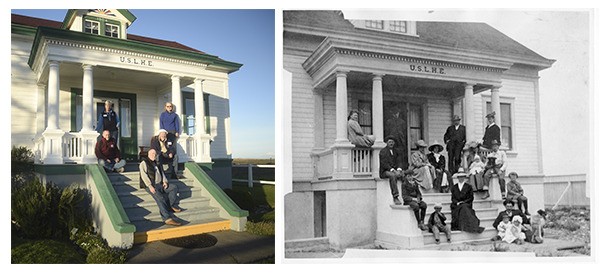Editor’s note: With time a handful of Sequim’s landmark structures have aged, yet still stand as quiet reminders of the past. In this series Gazette staffers take a step backward in time to compare these structures now from then and revisit the history, giving insight into the area’s early development.
Visible from 22 miles away, a light tirelessly shines from the New Dungeness Lighthouse denoting the Dungeness Spit, a long branch of land stretching into the Strait of Juan de Fuca and considered one of the world’s longest natural sand spits.
Although the first lard oil lamp that brought life to its 91-foot tower has been upgraded throughout time, its purpose has remained for the past 158 years.
The Dungeness Spit, sometimes referred to as “Shipwreck Spit” because of the shallow waters surrounding the notoriously long spit, was one of the first locations in the state recognized as an ideal spot for a lighthouse, Chad Kaiser, New Dungeness Light Station general manager explained.
“When choosing where to build lighthouses in this area, the most dangerous areas were identified first,” he said.
As the first U.S. lighthouse completed on the Strait of Juan de Fuca, the New Dungeness Lighthouse has helped guide those at sea since 1857.
“One thing that really makes our lighthouse stand out is it’s the second oldest lighthouse in Washington and has most of the extra buildings,” Kaiser said.
Unlike many historical lighthouses, the New Dungeness Lighthouse is surrounded by a lot of its original sub-structures to create an actual light station. Buildings have come and gone, however, a barn and oil house from the late 1800s, a second keeper’s dwelling built in 1904 and remnants of a tramway that once linked a boathouse to a fog signal building still accompany the lighthouse.
“In a marine environment the elements are always trying to consume the buildings,” Kaiser said. “We joke that it’s like owning a boat and an old house.”
By 1927, age and weather had taken their toll on the upper part of the lighthouse’s tower and in response the tower was lowered by 27.5 feet.
Shortly after 1994 when the U.S. Coast Guard no longer stationed keepers at the light station, a nonprofit known as the New Dungeness Light Station Association formed. Through a license from the U.S. Coast Guard for 32.5 acres, the association upkeeps the light station surrounded by the Dungeness National Wildlife Refuge.
Constant work, repair and upgrades are required to maintain the grounds and buildings and thus thousands of volunteer hours are spent year-round, Kaiser said.
The association initiated the Keeper Program where members act as keepers for a week and their fees help to maintain the light station.
Historically, a keeper and his family would live at the light station for years at a time, but for more than 20 years the Keeper Program has grown into a successful alternative to keep the light station in good condition and open to the public.
“People really like the opportunity and are able to gain a sense of ownership while being in such a unique and remote area,” Kaiser said.
Lighthouses have served as a safety and navigational mechanism for ships, but with advancements in technology, mapping capabilities and communication they’ve become more of a “secondary aid,” Kaiser said. However, last December volunteer keepers at the New Dungeness Light Station were able to provide emergency assistance to three boaters seeking refuge after experiencing threatening weather conditions.
The world around the New Dungeness Light Station continues to modernize and evolve, yet to visit it is like turning back the hands of time with the original structures and the lighthouse as an ageless beacon to all those nearby.
For more information on the New Dungeness Light Station Association, visit newdungenesslighthouse.com.
Reach Alana Linderoth at alinderoth@sequimgazette.com.
Did you know?
• A 665-foot artesian well serves the light station with flows of 80 gallons per minute.
• In 2014, 8,000 guests signed the light station guestbook, but it’s estimated about 10,000-12,000 visited.
• It’s an 11-mile roundtrip hike to the light station.
• The New Dungeness Light Station was added to the National Register of Historic Places in 1993.
• U.S. Coast Guard only maintains the Fresnel lens.
• It varies, but at its tip, the Dungeness Spit grows annually 7-13 feet.
• President Woodrow Wilson established the Dungeness National Wildlife Refuge in 1915 that encompasses the Dungeness Spit and some surrounding land and water.


